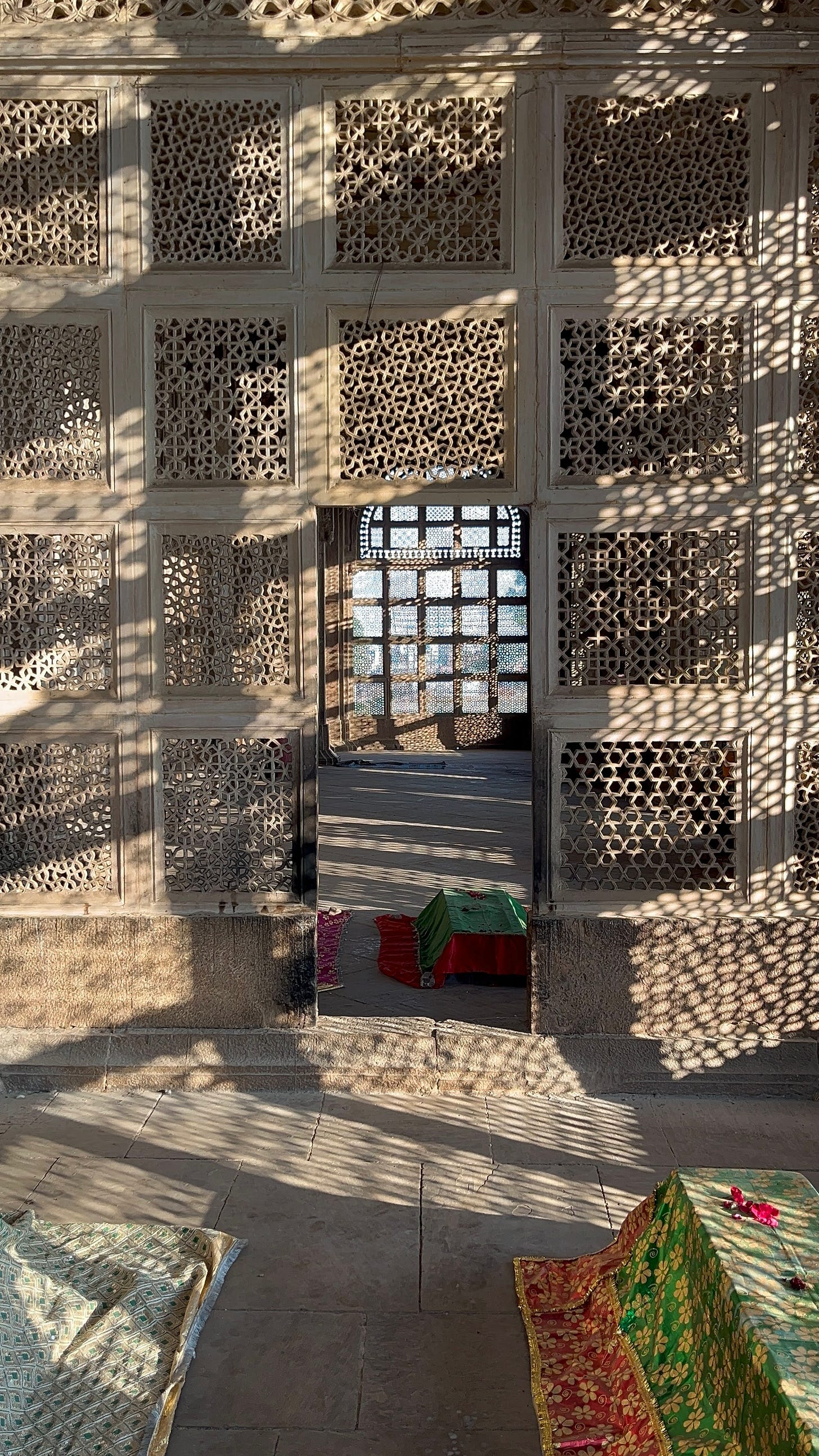The sights and sounds of Gwalior had thus far been muted, each moment steeped in the ordinariness of an ancient city caught in the race towards modernity. As we made our way to the next destination, our expectations were tempered, dulled by the underwhelming encounters of the previous days.
We let our car rest for the day and chose instead to weave through the city streets in an electric auto. These modest, humming chariots provide an economical passage, whisking tourists and locals from one corner of the town to another.
Engaged in a colorful conversation with our driver, we scarcely noticed our arrival until he cheerfully announced it. We disembarked, stepping into a narrow lane flanked by shops. The sun, still low on the horizon, cast a gentle glow over the passageway as we made our way toward the tomb of Ghaus Mohammad.
Sidenote: Built in the late 16th century by Mughal architects under the patronage of Emperor Akbar, this mausoleum is the final resting place of Ghaus Mohammad—a celebrated Sufi saint. Historical accounts suggest that Ghaus Mohammad served as a spiritual guide and teacher to Humayun during a period of his reign.
The remnants of a gate greeted us as we crossed into the complex. Before us stretched a manicured garden alive with movement—workers scurried about, erecting a pavilion in preparation for an impending cultural event. The scene, buzzing with activity, damped our spirits further.
And then, as if by divine orchestration, the sun broke free from the embrace of clustered trees. In an instant, the tomb was soaked in the soft, diffused light of sunrise, emerging like a mirage from the past.
In that very moment, our hearts were captured. Our earlier disillusionment dissolved and the trivialities of the world faded away as the tomb commanded every ounce of our attention.
As we approached the structure, its exquisite sandstone facade caught the eye, the stone glowing warmly in the morning light. The tomb is a symphony of Indo-Islamic architecture, with its square layout crowned by a magnificent dome.
The walls are adorned with intricate jaalis—latticework—each panel a marvel of geometric precision and artistic flourish. These screens, painstakingly carved by artisans centuries ago, allow light and air to permeate, creating an interplay of shadow and illumination within the tomb’s sanctum.
Stepping inside, we were struck by the serenity that enveloped the place. The interior is tranquil, its high ceilings amplifying the silence, broken only by the soft murmur of prayers from a lone devotee seated in a corner.
The scent of rose, marigolds and mogra, placed as offerings (chadar) on the tomb, blended harmoniously with the faint aroma of incense, creating an atmosphere that felt both sacred and welcoming.
Walking around the tomb, we brushed our fingers against the cool, weathered sandstone rails. We noticed pieces of paper tied delicately to the railings—wedding invitations. Locals believe that invoking the saint’s blessings ensures a harmonious and prosperous union. This practice, a testament to Ghaus Mohammad’s enduring legacy, speaks of the deep connection the people still feel with the saint’s spiritual power.
Sidenote: Born in the early 16th century, Ghaus Mohammad, originally known as Muhammad Ghawth, was not only a mystic but also a scholar of Persian and Arabic, a musician, and a translator. His translation of the Amritakunda from Sanskrit to Persian with name of Bahr al-Hayat (means Ocean of life) remains a testament to his intellectual and cultural syncretism. He also introduced a set of Yoga practices in Sufism.
The dome above, a hallmark of Mughal architecture, loomed majestically. Its surface, though worn by centuries of weather and time, still bore traces of the grandeur it once had. Carvings of floral motifs and geometric designs adorned the arches, their artistry a silent homage to the divine.
We circled back to the outer gardens, where the tomb’s surroundings came alive in the golden light of morning. The garden itself, a quadrilateral space bordered by paths, mirrored the Mughal penchant for symmetry and order, its design intended to evoke the gardens of paradise.
As the sun climbed higher, the tomb’s intricate jaalis cast patterns of light and shadow that danced on the ground. We found ourselves contemplating the life of the man buried here, a mystic whose wisdom transcended the barriers of faith, culture, and time. Ghaus Mohammad’s tomb is more than a resting place; it is a monument to harmony—of architecture, of faiths, of humanity itself.







